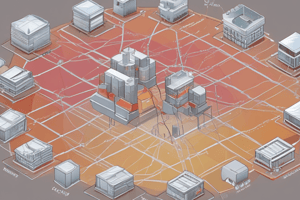Podcast
Questions and Answers
Which layer is responsible for managing dialogue control in the OSI model?
Which layer is responsible for managing dialogue control in the OSI model?
- Session Layer (correct)
- Presentation Layer
- Transport Layer
- Application Layer
What is the main purpose of the Network Layer in the OSI model?
What is the main purpose of the Network Layer in the OSI model?
- Providing access to the physical medium
- Routing packets from source to destination (correct)
- Ensuring data integrity and error correction
- Controlling the flow of data between applications
Which layer of the OSI model deals with data compression and encryption?
Which layer of the OSI model deals with data compression and encryption?
- Transport Layer
- Session Layer
- Presentation Layer (correct)
- Application Layer
Which of the following services is provided by the Data Link Layer?
Which of the following services is provided by the Data Link Layer?
What is the core purpose of the Transport Layer in the OSI model?
What is the core purpose of the Transport Layer in the OSI model?
What is the primary function of a protocol in a computer network?
What is the primary function of a protocol in a computer network?
What is the purpose of layering in network architecture?
What is the purpose of layering in network architecture?
Which of the following is NOT a key design issue for network layers?
Which of the following is NOT a key design issue for network layers?
Which layer in the OSI model converts logical 1s and 0s into electrical signals?
Which layer in the OSI model converts logical 1s and 0s into electrical signals?
What does a connection-oriented service provide in a network architecture?
What does a connection-oriented service provide in a network architecture?
What is the primary advantage of using a reference model like the OSI or TCP/IP?
What is the primary advantage of using a reference model like the OSI or TCP/IP?
What is the difference between a protocol and a network architecture?
What is the difference between a protocol and a network architecture?
Which of the following is considered a connectionless service?
Which of the following is considered a connectionless service?
Flashcards
Data Link Layer
Data Link Layer
Responsible for error control and flow control in data transmission.
Network Layer
Network Layer
Handles routing packets and logical addressing for data transmission.
Transport Layer
Transport Layer
Ensures quality of service and is central to the OSI model.
Session Layer
Session Layer
Signup and view all the flashcards
Connection-Oriented vs Connectionless
Connection-Oriented vs Connectionless
Signup and view all the flashcards
Network Architecture
Network Architecture
Signup and view all the flashcards
Protocol Hierarchies
Protocol Hierarchies
Signup and view all the flashcards
Services in Networking
Services in Networking
Signup and view all the flashcards
OSI Model
OSI Model
Signup and view all the flashcards
Connection Establishment
Connection Establishment
Signup and view all the flashcards
Error Control
Error Control
Signup and view all the flashcards
Physical Layer
Physical Layer
Signup and view all the flashcards
Network Protocol
Network Protocol
Signup and view all the flashcards
Study Notes
Computer Network Protocols - Study Notes
- Course: 4th Grade, 2022-2023
- Instructor: Dr. Mohammed Hasan Ali
Introduction
- Network Architectures: A set of layers and protocols.
- Protocol Hierarchies: Networks are organized in layers to simplify design. Each layer gives services to the layer above. An interface exists between layers. Services can be connection-oriented or connectionless. An interface defines what primitives and services a lower layer provides to the upper layer. Primitives are actions like request, indicate, response, and confirm.
- Design Issues for Layers (Functions):
- Establishing connections
- Data transfer rules
- Error control
- Handling situations where one device is much faster than another
- Handling very long messages
- Routing in complex networks with multiple paths
Why a Layered Model?
- Easier Communication: Makes teaching easier.
- Development Flexibility: Changes in one layer don't affect others.
- Hardware/Software Compatibility: Allows different hardware and software to work together.
- Simplified Complexity: Breaks down communication into smaller, simpler parts.
Protocol
- Format/Order of Messages: Provides a standardized format for messages sent and received among network entities. Indicates the steps and actions relating to message exchange.
- Protocol Process: The process encompasses how messages are formatted, the method used by network devices for sharing information about routes. It discusses how error and system messages are exchanged between network devices. It also includes setup and termination of data transfer sessions.
The OSI Model (Open System Interconnection)
- Theoretical Blueprint: Helps understand how data moves from one computer to another.
- Standard Development: Creates standards for hardware and software to better communicate with each other.
Reference Model
- Outline of Rules for Communication: Provides a blueprint or outline for how protocols can work to enable communication between computers.
- Layered Support: Each layer has its unique function and supports other layers.
OSI Model (Details)
- Layered Structure: The OSI model is a seven-layer architecture for computer networks.
- Layers and Functions: The layers handle different tasks, including application processes, data representation, inter-host communication, end-to-end connections, routing, access to media, binary transmissions, etc.
- Specific functions performed at each of the 7 layers.
OSI Model Protocols
- Specific protocols for each layer: Lists well known protocols associated with each of the seven OSI model layers. (e.g. HTTP, FTP, DNS on the Application layer).
OSI Model Layers & Functions (Detail)
- Physical Layer: Converts logical 0s and 1s into electrical signals for transmission. Deals with media, signal, and binary transmission.
- Data Link Layer: Handles error control, compensating for any imperfections in the physical layer. Controls the flow of data to prevent a fast sender from overwhelming a slow receiver. Logical addressing used within this layer.
- Network Layer: Controls the subnet, determines optimal route, and handles logical addressing.
- Transport Layer: Provides Quality of Service and is the foundation of the OSI Model.
- Session Layer: Manages communication sessions (dialogue) between different systems. Manages synchronization (token management), and dialogue control.
- Presentation Layer: Deals with the syntax and semantics (meaning) of the information being transferred and encryption.
- Application Layer: Provides protocols that applications need to exchange data.
OSI Services
-
Connection-Oriented & Connectionless:
- Connection-Oriented: A connection is established before data is sent.
- Connectionless: Data can be sent asynchronously.
-
Service Primitives:
- Request: An entity requests a service.
- Indicate: An entity is informed about an event.
- Response: An entity responds to an event.
- Confirm: An entity is informed about the service's acceptance of a request.
Studying That Suits You
Use AI to generate personalized quizzes and flashcards to suit your learning preferences.




